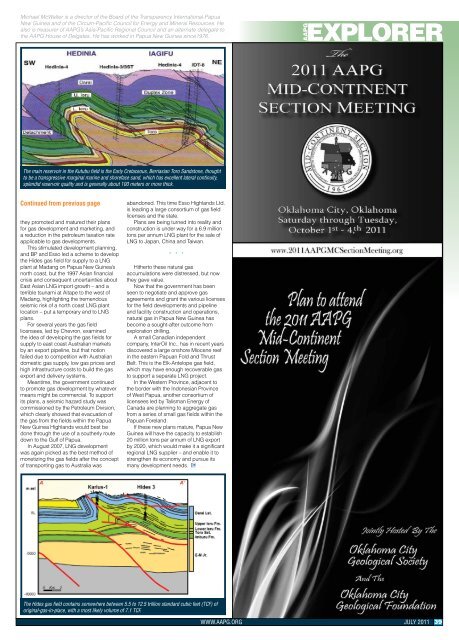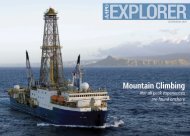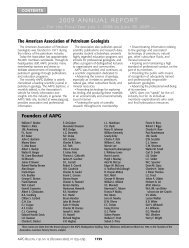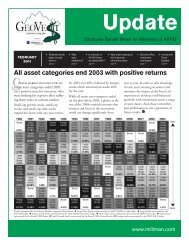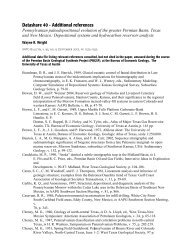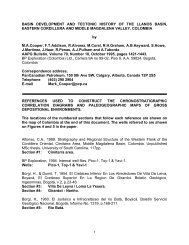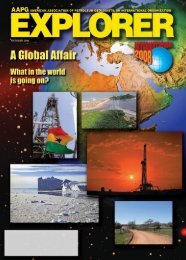AAPG Explorer - American Association of Petroleum Geologists
AAPG Explorer - American Association of Petroleum Geologists
AAPG Explorer - American Association of Petroleum Geologists
You also want an ePaper? Increase the reach of your titles
YUMPU automatically turns print PDFs into web optimized ePapers that Google loves.
Michael McWalter is a director <strong>of</strong> the Board <strong>of</strong> the Transparency International-Papua<br />
New Guinea and <strong>of</strong> the Circum-Pacific Council for Energy and Mineral Resources. He<br />
also is treasurer <strong>of</strong> <strong>AAPG</strong>’s Asia-Pacific Regional Council and an alternate delegate to<br />
the <strong>AAPG</strong> House <strong>of</strong> Delgates. He has worked in Papua New Guinea since1976.<br />
The main reservoir in the Kutubu field is the Early Cretaceous, Berriasian Toro Sandstone, thought<br />
to be a transgressive marginal marine and shoreface sand, which has excellent lateral continuity,<br />
splendid reservoir quality and is generally about 100 meters or more thick.<br />
Continued from previous page<br />
they promoted and matured their plans<br />
for gas development and marketing, and<br />
a reduction in the petroleum taxation rate<br />
applicable to gas developments.<br />
This stimulated development planning,<br />
and BP and Esso led a scheme to develop<br />
the Hides gas field for supply to a LNG<br />
plant at Madang on Papua New Guinea’s<br />
north coast, but the 1997 Asian financial<br />
crisis and consequent uncertainties about<br />
East Asian LNG import growth – and a<br />
terrible tsunami at Aitape to the west <strong>of</strong><br />
Madang, highlighting the tremendous<br />
seismic risk <strong>of</strong> a north coast LNG plant<br />
location – put a temporary end to LNG<br />
plans.<br />
For several years the gas field<br />
licensees, led by Chevron, examined<br />
the idea <strong>of</strong> developing the gas fields for<br />
supply to east coast Australian markets<br />
by an export pipeline, but that notion<br />
failed due to competition with Australian<br />
domestic gas supply, low gas prices and<br />
high infrastructure costs to build the gas<br />
export and delivery systems.<br />
Meantime, the government continued<br />
to promote gas development by whatever<br />
means might be commercial. To support<br />
its plans, a seismic hazard study was<br />
commissioned by the <strong>Petroleum</strong> Division,<br />
which clearly showed that evacuation <strong>of</strong><br />
the gas from the fields within the Papua<br />
New Guinea Highlands would best be<br />
done through the use <strong>of</strong> a southerly route<br />
down to the Gulf <strong>of</strong> Papua.<br />
In August 2007, LNG development<br />
was again picked as the best method <strong>of</strong><br />
monetizing the gas fields after the concept<br />
<strong>of</strong> transporting gas to Australia was<br />
abandoned. This time Esso Highlands Ltd.<br />
is leading a large consortium <strong>of</strong> gas field<br />
licenses and the state.<br />
Plans are being turned into reality and<br />
construction is under way for a 6.9 million<br />
tons per annum LNG plant for the sale <strong>of</strong><br />
LNG to Japan, China and Taiwan.<br />
* * *<br />
Hitherto these natural gas<br />
accumulations were distressed, but now<br />
they gave value.<br />
Now that the government has been<br />
seen to negotiate and approve gas<br />
agreements and grant the various licenses<br />
for the field developments and pipeline<br />
and facility construction and operations,<br />
natural gas in Papua New Guinea has<br />
become a sought-after outcome from<br />
exploration drilling.<br />
A small Canadian independent<br />
company, InterOil Inc., has in recent years<br />
discovered a large onshore Miocene reef<br />
in the eastern Papuan Fold and Thrust<br />
Belt. This is the Elk-Antelope gas field,<br />
which may have enough recoverable gas<br />
to support a separate LNG project.<br />
In the Western Province, adjacent to<br />
the border with the Indonesian Province<br />
<strong>of</strong> West Papua, another consortium <strong>of</strong><br />
licensees led by Talisman Energy <strong>of</strong><br />
Canada are planning to aggregate gas<br />
from a series <strong>of</strong> small gas fields within the<br />
Papuan Foreland.<br />
If these new plans mature, Papua New<br />
Guinea will have the capacity to establish<br />
20 million tons per annum <strong>of</strong> LNG export<br />
by 2020, which would make it a significant<br />
regional LNG supplier – and enable it to<br />
strengthen its economy and pursue its<br />
many development needs. EXPLORER<br />
The Hides gas field contains somewhere between 5.5 to 12.5 trillion standard cubic feet (TCF) <strong>of</strong><br />
original-gas-in-place, with a most likely volume <strong>of</strong> 7.1 TCF.<br />
<strong>AAPG</strong><br />
EXPLORER<br />
WWW.<strong>AAPG</strong>.ORG JULY 2011<br />
39


